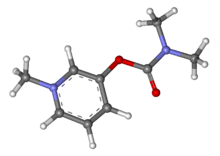Pyridostigmine
 | |
 | |
| Clinical data | |
|---|---|
| Trade names | Mestinon |
| AHFS/Drugs.com | Monograph |
| MedlinePlus | a682229 |
| Pregnancy category | |
| Routes of administration | Oral, intravenous |
| ATC code | N07AA02 (WHO) |
| Legal status | |
| Legal status | |
| Pharmacokinetic data | |
| Bioavailability | 7.6 +/- 2.4% |
| Biological half-life | 1.78 +/- 0.24hrs |
| Excretion | Renal |
| Identifiers | |
| |
| CAS Number |
155-97-5 |
| PubChem (CID) | 4991 |
| DrugBank |
DB00545 |
| ChemSpider |
4817 |
| UNII |
19QM69HH21 |
| KEGG |
D00487 |
| ChEMBL |
CHEMBL1115 |
| Chemical and physical data | |
| Formula | C9H13N2O2 |
| Molar mass | 181.212 g/mol |
| 3D model (Jmol) | Interactive image |
| |
| |
| (verify) | |
Pyridostigmine is a parasympathomimetic and a reversible cholinesterase inhibitor. Since it is a quaternary amine, it is poorly absorbed in the gut and cannot penetrate across the blood–brain barrier.[1]
It is on the WHO Model List of Essential Medicines, the most important medications needed in a basic health system.[2]
Medical uses
Pyridostigmine is used to treat muscle weakness in people with myasthenia gravis or forms of congenital myasthenic syndrome and to combat the effects of curariform drug toxicity. Pyridostigmine bromide has been FDA approved for military use during combat situations as an agent to be given prior to exposure to the nerve agent soman in order to increase survival. Used in particular during the first Gulf War, pyridostigmine bromide has been implicated as a causal factor in Gulf War syndrome.[3]
Pyridostigmine sometimes is used to treat orthostatic hypotension.[4] It may also be of benefit in chronic axonal polyneuropathy.[5]
It is also being prescribed 'off-label' for the postural tachycardia syndrome as well as complications resulting from Ehlers-Danlos Syndrome.[5][6]
Contraindications
Pyridostigmine bromide is contraindicated in cases of mechanical intestinal or urinary obstruction and should be used with caution in patients with bronchial asthma.[7][8]
Side effects
Common side effects include:[7]
- Sweating
- Diarrhea
- Nausea
- Vomiting
- Abdominal cramps
- Increased salivation
- Tearing
- Increased bronchial secretions
- Constricted pupils
- Facial flushing due to vasodilation
- Erectile dysfunction
Mechanism of action
In a synapse, action potentials are conducted along motor nerves to their terminals where they initiate a Ca2+ influx and the release of acetylcholine (ACh). The ACh diffuses across the synaptic cleft and binds to receptors on the post synaptic membrane, causing an influx of Na+, resulting in depolarization. If large enough, this depolarization results in an action potential. To prevent constant stimulation once the ACh is released, an enzyme called acetylcholinesterase is present in the endplate membrane close to the receptors on the post synaptic membrane, and quickly hydrolyses ACh.
Pyridostigmine inhibits acetylcholinesterase in the synaptic cleft, thus slowing down the hydrolysis of acetylcholine. It is a quaternary carbamate inhibitor of cholinesterase that does not cross the blood–brain barrier which carbamylates about 30% of peripheral cholinesterase enzyme. The carbamylated enzyme eventually regenerates by natural hydrolysis and excess ACh levels revert to normal.
Names
Pyridostigmine bromide is available under the trade names Mestinon (Valeant Pharmaceuticals), Regonol and Gravitor (SUN Pharma).
References
- ↑ Amourette C, Lamproglou I, Barbier L, et al. (November 2009). "Gulf War illness: Effects of repeated stress and pyridostigmine treatment on blood-brain barrier permeability and cholinesterase activity in rat brain". Behavioural Brain Research. 203 (2): 207–14. doi:10.1016/j.bbr.2009.05.002. PMID 19433115.
- ↑ "19th WHO Model List of Essential Medicines (April 2015)" (PDF). WHO. April 2015. Retrieved May 10, 2015.
- ↑ Golomb BA (March 2008). "Acetylcholinesterase inhibitors and Gulf War illnesses". Proceedings of the National Academy of Sciences of the United States of America. 105 (11): 4295–300. Bibcode:2008PNAS..105.4295G. doi:10.1073/pnas.0711986105. JSTOR 25461411. PMC 2393741
 . PMID 18332428. Lay summary – Reuters (March 10, 2008).
. PMID 18332428. Lay summary – Reuters (March 10, 2008). - ↑ Gales BJ, Gales MA (2007). "Pyridostigmine in the treatment of orthostatic intolerance". Annals of Pharmacotherapy. 41 (2): 314–8. doi:10.1345/aph.1H458. PMID 17284509.
- 1 2 Gales BJ, Gales MA (February 2007). "Pyridostigmine in the treatment of orthostatic intolerance". The Annals of Pharmacotherapy. 41 (2): 314–8. doi:10.1345/aph.1H458. PMID 17284509.
- ↑ Kanjwal K, Karabin B, Sheikh M, et al. (June 2011). "Pyridostigmine in the treatment of postural orthostatic tachycardia: a single-center experience". Pacing and Clinical Electrophysiology. 34 (6): 750–5. doi:10.1111/j.1540-8159.2011.03047.x. PMID 21410722.
- 1 2 Mestinon | Home
- ↑ Mestinon Official FDA information, side effects and uses
Related publications
- Brenner, G. M. (2000). Pharmacology. Philadelphia, PA: W.B. Saunders Company. ISBN 0-7216-7757-6
- Canadian Pharmacists Association (2000). Compendium of Pharmaceuticals and Specialties (25th ed.). Toronto, ON: Webcom. ISBN 0-919115-76-4
- Neal, M.J. (2002). Medical Pharmacology at a Glance (5th ed.). London, England: Blackwell Publishing. ISBN 1-4051-3360-0